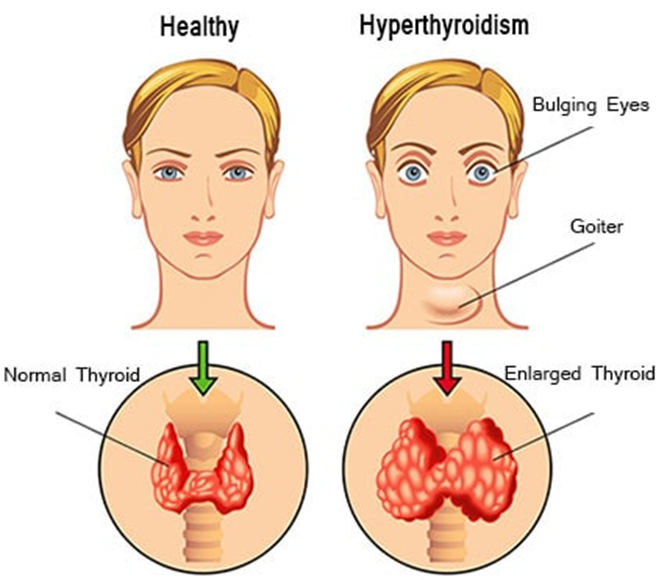A nurse is assessing a client who has hyperthyroidism. The nurse should expect the client to report which of the following manifestations?
Constipation
Sensitivity to cold
Weight gain of 4.5 kg (10 lbs) in 3 weeks
Frequent mood changes
The Correct Answer is D
Choice A Reason:
Constipation is not typically associated with hyperthyroidism. Hyperthyroidism usually speeds up the body’s metabolism, leading to symptoms like increased bowel movements or diarrhea rather than constipation.
Choice B Reason:
Sensitivity to cold is more commonly associated with hypothyroidism, where the body’s metabolism slows down. In hyperthyroidism, patients often experience heat intolerance due to an increased metabolic rate.
Choice C Reason:
Weight gain of 4.5 kg (10 lbs) in 3 weeks is also more indicative of hypothyroidism. Hyperthyroidism generally causes weight loss despite an increased appetite because of the accelerated metabolism.
Choice D Reason:
Frequent mood changes are a common symptom of hyperthyroidism. The excess thyroid hormones can affect the nervous system, leading to symptoms such as anxiety, irritability, and mood swings.

Free Nursing Test Bank
- Free Pharmacology Quiz 1
- Free Medical-Surgical Quiz 2
- Free Fundamentals Quiz 3
- Free Maternal-Newborn Quiz 4
- Free Anatomy and Physiology Quiz 5
- Free Obstetrics and Pediatrics Quiz 6
- Free Fluid and Electrolytes Quiz 7
- Free Community Health Quiz 8
- Free Promoting Health across the Lifespan Quiz 9
- Free Multidimensional Care Quiz 10
View Related questions
Correct Answer is C
Explanation
Choice A: Exophthalmos
Exophthalmos, or bulging eyes, is not a typical symptom of hypothyroidism. Instead, it is commonly associated with hyperthyroidism, particularly Graves’ disease. In hypothyroidism, the thyroid gland is underactive, leading to a different set of symptoms.
Choice B: Photophobia
Photophobia, or sensitivity to light, is not a common symptom of hypothyroidism. While hypothyroidism can cause a variety of symptoms, photophobia is more often associated with conditions affecting the eyes or the nervous system.
Choice C: Lethargy
Lethargy, or extreme fatigue, is a common symptom of hypothyroidism. When the thyroid gland does not produce enough thyroid hormones, the body’s metabolism slows down, leading to feelings of tiredness and lack of energy. This is one of the hallmark symptoms of hypothyroidism and can significantly impact a person’s daily life.
Choice D: Weight Loss
Weight loss is not typically associated with hypothyroidism. In fact, weight gain is more common due to the slowed metabolism caused by an underactive thyroid. Individuals with hypothyroidism often experience difficulty losing weight and may gain weight even with a normal diet and exercise routine.
Correct Answer is B
Explanation
Choice A reason:
Saying “Maybe next time you can have a vaginal delivery” is not supportive and may minimize the client’s current feelings of disappointment. It is important to acknowledge and validate the client’s emotions rather than focusing on future possibilities.
Choice B reason:
This response, “It sounds like you are feeling sad that things didn’t go as planned,” is empathetic and validates the client’s feelings. It shows that the nurse is listening and understands the client’s disappointment, which is crucial for emotional support.
Choice C reason:
While it is true that having a healthy baby is important, saying “At least you know you have a healthy baby” can come across as dismissive of the client’s feelings. It is essential to address the client’s emotions directly rather than shifting the focus.
Choice D reason:
Telling the client “You can resume sensations sooner than if you had delivered vaginally” is not relevant to the client’s expressed feelings of disappointment about not having a natural childbirth. This response does not address the emotional aspect of the client’s experience.

